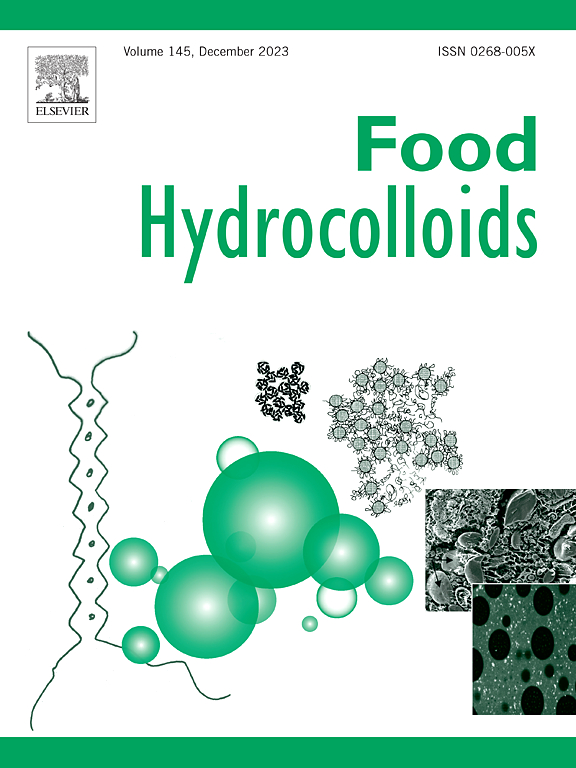Study of Zn2+ complexation driven zein-based W/O/W Pickering emulsions for enhancing curcumin bioaccessibility and fluorouracil bioactivity
IF 11
1区 农林科学
Q1 CHEMISTRY, APPLIED
引用次数: 0
Abstract
Overcoming gastrointestinal tract barriers to enhance bioavailability is a major challenge for oral delivery. The innovative design of multi-compartment functional Pickering emulsions would provide an ideal option for targeted co-delivery of bioactive components. In this study, pH-responsive water-in-oil-in-water (W/O/W) Pickering double emulsions co-loaded with curcumin and fluorouracil were fabricated by zein/anthocyanin (ACN)/Zn2+ nanoparticles (ZAZn NPs) via a one-step emulsification process. The unique emulsifier was designed by depositing ACN-Zn2+ complexes on zein nanoparticles (zein NPs). The binding of ACN to the nanoparticle surface through hydrogen bonding interaction enhanced the hydrophilization and stimuli-response of zein NPs. Furthermore, the co-ordination of Zn2+ and ACN facilitated the formation of nanoparticles with near-neutral wettability, which served as the dominant driving force for the one-step generation of W/O/W Pickering emulsions. The droplet size, distribution and internal structure of Pickering double emulsions were influenced by nanoparticle concentration and oil fraction. Due to Zn2+ complexation with curcumin at the oil/water interface, the W/O/W Pickering emulsions obtained exhibited high curcumin encapsulation efficiency (91.2%) and free fatty acid release degree (65.9%), resulting in increased bio-accessibility (71.0%). The simulated gastrointestinal release demonstrated that curcumin and fluorouracil achieved controlled intestinal release, which was driven by a pH-mediated competitive adsorption-desorption mechanism. Moreover, in vitro cell experiments showed that co-encapsulated Pickering double emulsions exhibited 2.5 times greater bio-activity than those containing fluorouracil only. This facile strategy for preparing Pickering double emulsions is promising for the co-delivery of different physico-chemical bio-active compounds, which would improve oral bio-accessibility and bio-activity.

Zn2+络合驱动玉米蛋白基W/O/W Pickering乳剂提高姜黄素生物可及性和氟尿嘧啶生物活性的研究
克服胃肠道障碍以提高生物利用度是口服给药的主要挑战。多室功能皮克林乳剂的创新设计将为生物活性成分的靶向共递送提供理想的选择。本研究以玉米蛋白/花青素(ACN)/Zn2+纳米粒子(ZAZn NPs)为原料,采用一步乳化工艺制备了ph响应型的姜黄素/氟尿嘧啶双包水(W/O/W) Pickering乳剂。通过在玉米蛋白纳米颗粒(玉米蛋白NPs)上沉积ACN-Zn2+配合物,设计了独特的乳化剂。ACN通过氢键相互作用与纳米颗粒表面结合,增强了玉米蛋白NPs的亲水性和刺激响应。此外,Zn2+和ACN的协同作用促进了润湿性接近中性的纳米颗粒的形成,这是一步生成W/O/W Pickering乳状液的主要驱动力。纳米颗粒浓度和油分对皮克林双乳的粒径、分布和内部结构均有影响。由于Zn2+与姜黄素在油水界面的络合作用,得到的W/O/W Pickering乳剂具有较高的姜黄素包封率(91.2%)和游离脂肪酸释放度(65.9%),提高了生物可及性(71.0%)。模拟胃肠道释放表明,姜黄素和氟尿嘧啶在ph介导的竞争性吸附-解吸机制驱动下实现了可控的肠道释放。此外,体外细胞实验表明,共包封皮克林双乳的生物活性是仅含氟尿嘧啶双乳的2.5倍。这种制备皮克林双乳剂的简便策略有望用于不同物理化学生物活性化合物的共递送,从而提高口服生物可及性和生物活性。
本文章由计算机程序翻译,如有差异,请以英文原文为准。
求助全文
约1分钟内获得全文
求助全文
来源期刊

Food Hydrocolloids
工程技术-食品科技
CiteScore
19.90
自引率
14.00%
发文量
871
审稿时长
37 days
期刊介绍:
Food Hydrocolloids publishes original and innovative research focused on the characterization, functional properties, and applications of hydrocolloid materials used in food products. These hydrocolloids, defined as polysaccharides and proteins of commercial importance, are added to control aspects such as texture, stability, rheology, and sensory properties. The research's primary emphasis should be on the hydrocolloids themselves, with thorough descriptions of their source, nature, and physicochemical characteristics. Manuscripts are expected to clearly outline specific aims and objectives, include a fundamental discussion of research findings at the molecular level, and address the significance of the results. Studies on hydrocolloids in complex formulations should concentrate on their overall properties and mechanisms of action, while simple formulation development studies may not be considered for publication.
The main areas of interest are:
-Chemical and physicochemical characterisation
Thermal properties including glass transitions and conformational changes-
Rheological properties including viscosity, viscoelastic properties and gelation behaviour-
The influence on organoleptic properties-
Interfacial properties including stabilisation of dispersions, emulsions and foams-
Film forming properties with application to edible films and active packaging-
Encapsulation and controlled release of active compounds-
The influence on health including their role as dietary fibre-
Manipulation of hydrocolloid structure and functionality through chemical, biochemical and physical processes-
New hydrocolloids and hydrocolloid sources of commercial potential.
The Journal also publishes Review articles that provide an overview of the latest developments in topics of specific interest to researchers in this field of activity.
 求助内容:
求助内容: 应助结果提醒方式:
应助结果提醒方式:


